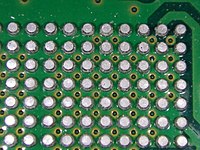
Photo from wikipedia
Abstract This study investigates the machinability performance during dry longitudinal turning of Ti-6Al-4V-ELI titanium alloy using Taguchi Experimental Design (TED) and full factorial design (FFD). Main cutting force (Fc) and… Click to show full abstract
Abstract This study investigates the machinability performance during dry longitudinal turning of Ti-6Al-4V-ELI titanium alloy using Taguchi Experimental Design (TED) and full factorial design (FFD). Main cutting force (Fc) and mean surface roughness (Ra) are selected as the output machinability parameters. Spindle speed (n), feed rate (s) and depth of cut (a) are the independent input cutting variables, each one having three different levels. A complete combination array of 27 (33) experiments was realized and the machinability performance is recorded. Then, the “full 27-array” is divided in three sub-arrays, each one having the “orthogonality property-OP” according to Taguchi L9 array. The performance of each sub-array is analyzed using both stem-and-leaf and box plots, as well as analysis of means (ANOM) and analysis of variance (ANOVA) and is compared with the FFD one. Data analysis (DA) during present study indicates that Taguchi design is appropriate for analyzing machinability issues of “difficult-to-cut” materials.
Journal Title: Measurement
Year Published: 2020
Link to full text (if available)
Share on Social Media: Sign Up to like & get
recommendations!